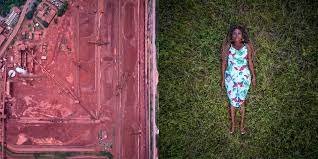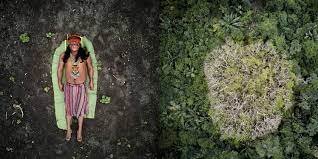Meet 30 Million Of The Amazon’s Strongest Environmentalists

Share This Article
The stunning photographs of Pablo Albarenga highlight the human rights and environmental issues affecting the indigenous tribes of the Amazon.
‘Environmentalist’ was one of the terms that came to mind when I saw photographer, Pablo Albarenga’s images of indigenous Amazons. A grantee of the Pulitzer Center, his vibrant photographs highlight the strength of a group of people determined to protect their land. Many of us remember hearing in 2020, “Our home is on fire,” when parts of the Amazon were in flames. Yet, for the men, women, and children who live within the shelter of the rainforest’s walls, their home isn’t just under an occasional fire, it’s under constant gunfire from industries who see the Amazon as nothing more than resources and dollar symbols. Sadly, it’s the indigenous Amazons who are the strongest environmental activists for the rainforest and are oftentimes caught in this gunfire. Yet, their strength, intelligence, and resistance live on as they take the international stage through speeches, demonstrations, and images like these that tell their story to the world.
I try to break stereotypes about how we think indigenous cultures should look like.
Pablo Albarenga
Seeds of Resistance

Drica lies in a bed of grass. The rich green cradles her brown limbs in her blue dress. Long honey-colored braids swirl in the leaves. This is her home- her ancestral land. The camera captures her in an aerial shot. Besides her is a mine- a wide stretch of dust with green trees speckling the rust-colored image. The images are side by side, the protagonist and antagonist.
Drica is one of 30 million people living in the Amazon who are up against loggers, miners, and other industries poaching their land. The picture of the mine next to her is one of the biggest foes that she faces. In an ongoing battle between big industries and indigenous communities. 1,000 indigenous lives were lost between 2013-2016. In 2017, 207 environmentalists were killed. Yet, the battle is not yet over. “Just while we’re talking on the phone there are at least 10 indigenous villages in Brazil being invaded,” Pablo, the Uruguayan photographer who captured the stoic image explains. “These territories are being looted and destroyed, but these lands are sacred, they’re where their [indigenous tribes] ancestors still rest.”
Defenders Of The Amazon
Drica, a formidable leader in her own right as the first female elected as the Quilombola Territory Coordinator isn’t the only defender of the Amazon that Pablo has photographed. He was also invited to photograph the campaign of Sonia Guajajara, the first indigenous woman running for the Vice-Presidency of Brazil in 2018. Pablo praised Sonia’s use of dress to challenge the international community’s stereotype of indigenous communities. “She uses her traditional clothing and accessories because she wants to establish who she is.” Indeed, that’s exactly what Sonia did when she stood before the UN in a bold headdress during her speech for ‘Indigenous Women of the Amazon’. Her words for 2019 were a battle cry for stronger initiatives to be taken to stop climate change and for protection for the communities up against corporations destroying the Amazon for profit.
Everyone who fights for environmental and for human rights is under risk. Unfortunately, these are not only threats anymore: murders are happening every day all over Brazil.
Sonia Guajajara
In 2019 when the world heard about the Amazon fires, few media outlets covered the people. Among all the images of trees and stories about rare bird species lost, few headlines highlighted the plight of the 30 million people whose homes were literally on fire. “That was a huge failure to me,” Pablo lamented. “So, I try to share these amazing stories about the indigenous Amazons- human struggles that have to do with the rainforest, identity building, many things.”
A Journey To Truth

All education here in Uruguay taught us that the indigenous have been extinguished. We were lied to. We were denied our past.
Pablo Albarenga
In 2015 Pablo quit his job as a business development manager and enrolled in classes to study photography. At the time, one of his teachers was featuring images of indigenous tribes from Paraguay. “Those images were very different from what I expected them to be,” Pablo said of his initial reaction. “We grew up with images of indigenous cultures being savage and with no technology. But, in these photographs, they were wearing Western clothes. They rode bicycles.” Pablo’s shock only grew when he began researching indigenous cultures in Latin America. “Growing up in Uruguay we were convinced that we were descendants of Europeans and that all of our indigenous ancestors had been wiped out.” When Pablo became aware of the plight indigenous Amazons were facing at that very moment to protect their lands, the photographer was stunned that no one else knew. “A lot of my friends and family didn’t have any idea what was happening to indigenous cultures.”

Fewer realized that they were most likely indigenous themselves. During his research, Pablo found out that ⅓ of people in Uruguay have indigenous ancestry from their mother’s side. Yet, thanks to the lasting effects of colonization rewriting history, “We’ve been taught that the indigenous have been extinguished. We denied our past.” But, as the famous quote goes, “ They tried to bury us, but didn’t realize that we were seeds.” It’s this quote that Pablo has based his latest work on. For every leader who is killed in this fight one hundred more sprout up. For every Latin American who is lied to about their ancestry, one photograph can awaken the eyes of millions.
A Sacred Place

Most people reading this article look at their home as a territory, something conquered and brought, a mortgage, a lease, an exchange often rooted in money. Indeed, the Amazon is a rich money maker on its own ripe with gold, wood, and unknown species for science. And, many of these industries are the people who these indigenous cultures are fighting. Yet, as Pablo explained to me the relationship that many of these tribes in the Amazon have with their home is quite different than mine or yours. The Amazon is sacred, it’s their life source, and it’s a support system. You and I go to stores for what we need. But, for women like Drica and Sonia, “the rainforest is a pharmacy, a supermarket, a burial ground of their ancestors, it’s their life source and they’ve been living and surviving there for centuries.”
